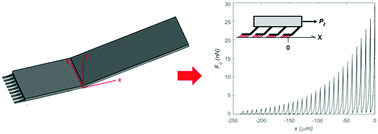Emergence of the interplay between hierarchy and contact splitting in biological adhesion highlighted through a hierarchical shear lag model
Abstract
Contact unit size reduction is a widely studied mechanism as a means to improve adhesion in natural fibrillar systems, such as those observed in beetles or geckos. However, these animals also display complex structural features in the way the contact is subdivided in a hierarchical manner. Here, we study the influence of hierarchical fibrillar architectures on the load distribution over the contact elements of the adhesive system, and the corresponding delamination behaviour. We present an analytical model to derive the load distribution in a fibrillar system loaded in shear, including hierarchical splitting of contacts, i.e. a “hierarchical shear-lag” model that generalizes the well-known shear-lag model used in mechanics. The influence on the detachment process is investigated introducing a numerical procedure that allows the derivation of the maximum delamination force as a function of the considered geometry, including statistical variability of local adhesive energy. Our study suggests that contact splitting generates improved adhesion only in the ideal case of extremely compliant contacts. In real cases, to produce efficient adhesive performance, contact splitting needs to be coupled with hierarchical architectures to counterbalance high load concentrations resulting from contact unit size reduction, generating multiple delamination fronts and helping to avoid detrimental non-uniform load distributions. We show that these results can be summarized in a generalized adhesion scaling scheme for hierarchical structures, proving the beneficial effect of multiple hierarchical levels. The model can thus be used to predict the adhesive performance of hierarchical adhesive structures, as well as the mechanical behaviour of composite materials with hierarchical reinforcements.



 Please wait while we load your content...
Please wait while we load your content...